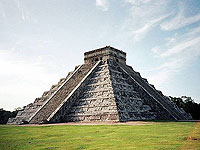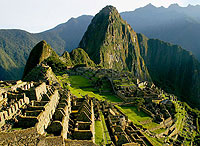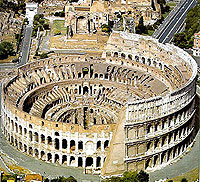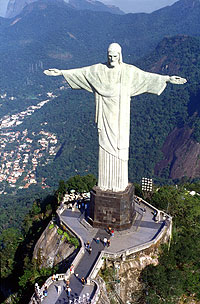بس واحد منهم مثل حدائق بابل المعلقة و الاهرامات
ضروري بسرعة أبا حق باجر

The most remarkable or amazing creations by mankind are included in the list of seven wonders of the world. The number 7 is said to symbolize perfection and hence is used to list the wonders. The seven wonders of the ancient times, due to destruction are no longer available for people to see. Thus, the need to find out new wonder may have arisen. The information about both ancient and new seven wonders is provided in the paragraphs below.
Seven Ancient Wonders of the World
Here is a list of seven ancient wonders of the world. It provides information in short about the oldest seven wonders known as of today.
Pyramids of Egypt
The three pyramids located in Giza near Cairo are one of the seven ancient wonders of the world. Among the three pyramids, the largest was built in ancient Egypt by a king of the fourth dynasty, called Khufu. Approximate height of the largest pyramid is 450 feet and its construction was completed in 2680 B.C.
Temple of Artemis
The construction of temple of Artemis had started in 350 B.C. and was built in the honor of Diana, a non-Hellenic goddess. The need to state the word, ‘non-Hellenic’ arises due to the fact that, the name Diana got associated with a Greek goddess later on. The Temple of Artemis which is located in Ephesis was destroyed by Goths during the invasion in 262 A.D.
Colossus of Rhodes
The colossus of Rhodes depicts the sun god, Helius and was built by Chares from Rhodes (formerly known as Lindus). This 105 feet statue was destroyed during an earthquake which occurred in 224 B.C. It is said that ships which came to the harbor passed between the legs of this huge statue.
The Statue of Zeus
The statue was built around 432 B.C. and erected in the Zeus (Jupiter) temple of Olympia. This 39 feet high statue was made of ivory and gold. Wooden frames were used in the construction by the sculptor Phidias who created this statue.
Hanging Gardens of Babylon
Built around 600 B.C. by Nebuchadnezzar II, The Hanging Gardens of Babylon was built by king Nebuchednezzar in 600 B.C (circa), in an attempt to please his wife, Amytis (also known as Amuhia). The Hanging Gardens which was laid above a vaulted building had the facility of raising water. The height of different terraces on the Hanging Garden varied from 75 to 300 feet.
The Pharos of Alexandria
The Pharos (Lighthouse) of Alexandria was built in Alexandria, Egypt on an island called Pharos. It was constructed by Soatratus, a Greek architect. Estimates of the height of this building vary between 115 m and 135 m. During an earthquake which occurred in the 13th century building got destroyed.
The Mausoleum at Halicarnassus
This monument was built by Queen Artemisia in the memory of king Mausolus, her husband. The mausoleum at Halicarnassus which is actually a tomb has an approximate height of 45 m.
Seven Modern Wonders of the World
The modern wonders include 6 new and an ancient world wonder. The Giza Pyramid complex is the only ancient wonder to feature in this list. The remaining 6 wonders are enlisted below.
Christ the Redeemer
A statue of Jesus Christ located in Rio De Janeiro, Brazil, Christ the Redeemer has a height of 39.6 m and is the largest ‘Art Deco’ statue.
The Great Wall of China
A series of walls built on the northern border of China, it was constructed and maintained during the period between 5th and 16th century. The Great Wall of China that we see today was constructed in the Ming dynasty. Qin Shi Huang, the first emperor of China had built a wall, the remains of which are found even today. It was built between 220 B.C. and 206 B.C.
Taj Mahal
It is a mausoleum built by Shah Jahan a Mughal emperor in the memory of Mumtaz Mahal, his wife. The Taj Mahal is located at Agra, India and was constructed between 1632 A.D. And 1648 A.D.
Chichen Itza
The word Chichen can be broken into ‘chi’ and ‘ch’e’en’, which means ‘mouth’ and ‘well’ respectively. Itza is an ethnic group of northern peninsula of Mexico. The name, Chichen Itza thus, translates as, ‘at the mouth of well of Itza’. This pyramidal structure was built during the Mayan civilization.
Petra
A rock city carved in red stone at Jordan by Nabataens, is one of the major tourist attractions. It has been described as a "rose-red city half as old as time". It remained hidden from the western world till 1812, when Swiss explorer Johann Burckhardt discovered it. UNESCO has described it as "one of the most precious cultural properties of man’s cultural heritage".
Machu Picchu
An archaeological site located at a height of 2,430 m in the Urubamba Valley, Peru, Machu Picchu is 80 km. away from Cuzco. The construction of Machu Picchu started in 1400 A.D. during the Inca civilization, however, the site was abandoned later on.
Apart from the ancient and modern wonders, the seven natural wonders of the world include Mount Everest, Victoria Falls, Great Barrier Reef, Harbor of Rio de Janeiro, Paricutin Volcano, Aurora and Grand Canyon. The list of ancient and modern seven wonders of the world presents before us the richness of culture and architecture of our ancestors.
There are a variety of amazing places all over the globe but the 7 wonders of the world are the most awe-inspiring. These natural wonders of the world can be found on five different continents and are magnificent in their natural beauty.
|
If YOU have been to one of these Natural Wonders of the World. Don’t keep it to yourself.Share Your Experience with us click on this link.
|
Victoria Falls is one of the seven wonders of the world, stretching 1.7 kilometres wide and shared by the countries of Zambia and Zimbabwe. The falls are formed as the full width of the Zambezi river plummets into a 108 metre high cleft. During the wet season, the spray from the falls can be seen nearly 50 kilometres away, hence the name Mosi-oa-Tunya (the ‘Smoke that Thunders’).
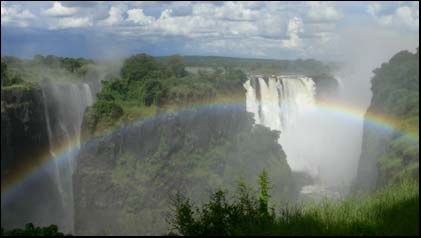
Aurora Borealis, another one of the natural wonders of the world, appears in the North sky and is visible only from the Northern Hemisphere. These northern polar lights appear inadvertently from September to October and March to April. The Aurora Borealis is named after the Roman goddess of dawn, Aurora and the Greek name for the north wind, Boreas. Often seen as a greenish glow or occasionally a faint red, the lights consist of solar wind and particles that appear as “curtains” or streamers extending in an east-west direction across the sky. Shaped by the earth’s magnetic field, the lights are constantly changing and evolving. The Cree call this phenomenon the “Dance of the Spirits.”
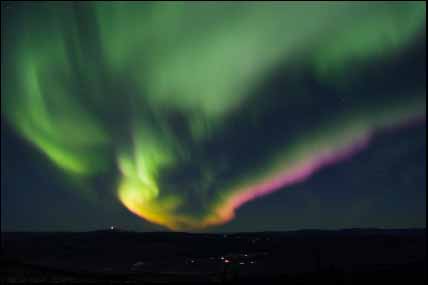

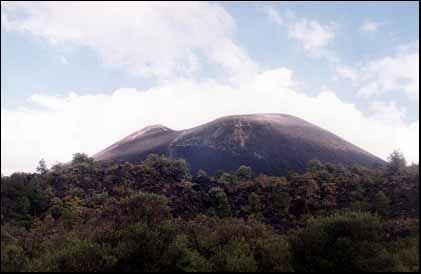
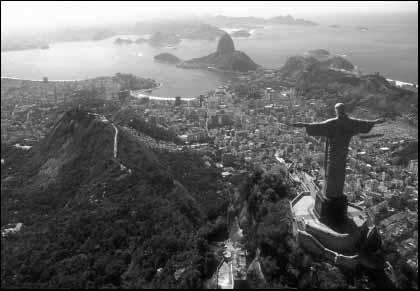
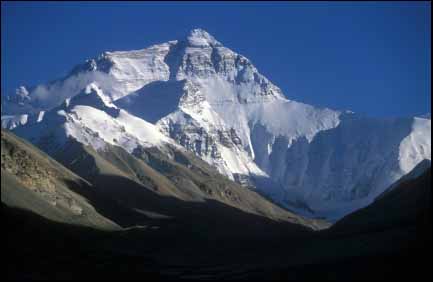
Great Barrier Reef
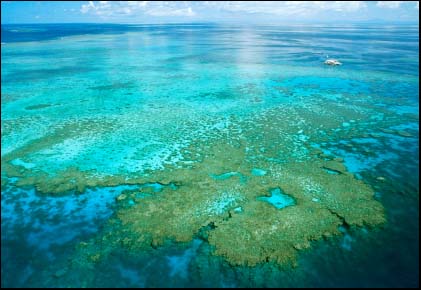
والثاني:
The most remarkable or amazing creations by mankind are included in the list of seven wonders of the world. The number 7 is said to symbolize perfection and hence is used to list the wonders. The seven wonders of the ancient times, due to destruction are no longer available for people to see. Thus, the need to find out new wonder may have arisen. The information about both ancient and new seven wonders is provided in the paragraphs below.
Seven Ancient Wonders of the World
Here is a list of seven ancient wonders of the world. It provides information in short about the oldest seven wonders known as of today.
Pyramids of Egypt
The three pyramids located in Giza near Cairo are one of the seven ancient wonders of the world. Among the three pyramids, the largest was built in ancient Egypt by a king of the fourth dynasty, called Khufu. Approximate height of the largest pyramid is 450 feet and its construction was completed in 2680 B.C.
Temple of Artemis
The construction of temple of Artemis had started in 350 B.C. and was built in the honor of Diana, a non-Hellenic goddess. The need to state the word, ‘non-Hellenic’ arises due to the fact that, the name Diana got associated with a Greek goddess later on. The Temple of Artemis which is located in Ephesis was destroyed by Goths during the invasion in 262 A.D.
Colossus of Rhodes
The colossus of Rhodes depicts the sun god, Helius and was built by Chares from Rhodes (formerly known as Lindus). This 105 feet statue was destroyed during an earthquake which occurred in 224 B.C. It is said that ships which came to the harbor passed between the legs of this huge statue.
The Statue of Zeus
The statue was built around 432 B.C. and erected in the Zeus (Jupiter) temple of Olympia. This 39 feet high statue was made of ivory and gold. Wooden frames were used in the construction by the sculptor Phidias who created this statue.
Hanging Gardens of Babylon
Built around 600 B.C. by Nebuchadnezzar II, The Hanging Gardens of Babylon was built by king Nebuchednezzar in 600 B.C (circa), in an attempt to please his wife, Amytis (also known as Amuhia). The Hanging Gardens which was laid above a vaulted building had the facility of raising water. The height of different terraces on the Hanging Garden varied from 75 to 300 feet.
The Pharos of Alexandria
The Pharos (Lighthouse) of Alexandria was built in Alexandria, Egypt on an island called Pharos. It was constructed by Soatratus, a Greek architect. Estimates of the height of this building vary between 115 m and 135 m. During an earthquake which occurred in the 13th century building got destroyed.
The Mausoleum at Halicarnassus
This monument was built by Queen Artemisia in the memory of king Mausolus, her husband. The mausoleum at Halicarnassus which is actually a tomb has an approximate
height of 45 m.
والثالث:
| Modern Seven Wonders of The World | |||||||||||||||||||||||
والرابع: The Seven Wonders of the Ancient World
The ancient Greek historian Herodotus began to compile a list of the Ancient Wonders of the World as early as the fifth century BC. In the second century BC complete lists of Seven Wonders were made, although most did not contain the Pharos of Alexandria but instead included the Walls of Babylon. In the sixth century AD, the Walls of Babylon had been replaced by the Pharos, and by the Middle Ages a list was agreed upon that still exists today. These Seven Ancient Wonders are described in the paragraphs below, appearing in chronological order. The Pyramids of Giza
Of all the wonders of the ancient world, the Great Pyramid is by far the most well known. The construction of pyramids in Egypt probably began about 2700 BC, when an architect named Imhotep built a step pyramid at aqqrah out of stone blocks rather than the traditional mud bricks. This pyramid was to be the tomb of Zoser, the second pharaoh of the third dynasty, who reigned form 2737-2717 BC. The design for the step pyramid was modified by other third dynasty pharaohs, and by the beginning of the fourth dynasty King Snefru constructed the first true pyramid at Dahshor. The design of the true pyramid was again used by Snefru’s son Khufu (Greek: Cheops), who built the first of the three pyramids at Giza. Khufu’s pyramid, known as the Great Pyramid, is the largest of the three, with an original height of 481 feet and a base length of 755 feet per side. The height today is only 451 feet, the result of looters stripping the outer white limestone and the slight settling of the pyramid base. Approximately 2.3 million blocks went into the Great Pyramid, each weighing about 2.5 tons. The Greek historian Herodotus wrote that the Great Pyramid was constructed over a 20 year period with the labor of about 100,000 men. The precision of the architecture is reflected in that the four corners of the base are in alignment with the four points of the compass. Some of the outer limestone still remains atop the second pyramid, which was built by Khufu’s son Khafer (Chephren), who succeeded his brother Redjedef (2613-2603 BC) to the throne. Khafer’s pyramid was 471 feet high when constructed, with the base about 707 feet per side. The Great Sphinx, located very near the pyramids, is said to have the face of Khafer and the body of a lion. The last of the immense Giza pyramids was built by Menkaure (Mycerinus), who ruled from 2578 to 2553 BC. This pyramid is the smallest of the three, reaching a height of only 218 feet and base lengths of 356 feet. The Hanging Gardens of Babylon
The Hanging Gardens of Babylon were built at the Royal Palace of Babylonia, which was located on the Euphrates river about 50 km south of modern Baghdad, Iraq. There are two accounts as to the creation of the Gardens. The more popular belief is that King Nebuchadnezzar II (604-562 BC) of Babylonia built them to comfort his wife, Amyitis, who missed the mountain surroundings of her homeland. The other possible creator of the Gardens is Queen Sammu-ramat (Semiramis), who lived two centuries before Nebuchadnezzar. There are no known remains of the Gardens that would verify their existence. In fact, only ancient Greek historians and poets mention the Gardens; Babylonian writings say nothing of them. Many people today believe that the Hanging Gardens of Babylon never existed, that the Greek poets and historians saw them only in their own minds. However, if they did exist as the Greeks claim, they contained elevated terraces that were stepped to form mountain-like structures. Exotic plants and animals inhabited the gardens, and large irrigation systems pumped water throughout the terraces. The Greek historian Philo wrote of the Gardens: "The Hanging Garden has plants cultivated above ground level, and the roots of the trees are embedded in an upper terrace rather than in the earth. The whole mass is supported on stone columns… Streams of water emerging from elevated sources flow down sloping channels… These waters irrigate the whole garden saturating the roots of plants and keeping the whole area moist. Hence the grass is permanently green and the leaves of trees grow firmly attached to supple branches… This is a work of art of royal luxury and its most striking feature is that the labor of cultivation is suspended above the heads of the spectators."
Statue of Zeus
The Statue of Zeus was crafted over an eight year period at Olympia, Greece and was finished in 430 BC. Phidias, its creator, was perhaps the finest sculptor in all of the ancient world. A magnificent temple was constructed to house the 40 ft. tall statue. This temple attained a religious significance far greater than any other Greek temple in the world of antiquity. The magnificent statue was made primarily of gold and ivory molded over a wooden frame. The King of Gods was depicted as sitting on his throne with a symbol of Nike (victory) in his right hand and a scepter crowned by an eagle in his left. The statue was decorated with ebony, ivory, precious stones, silver, gold, sphinxes and winged symbols of victory. The Temple flourished until the fourth century AD, when it was closed after the Olympic Games were banned by the Christian Emperor Theodosius. Fires, floods and earthquakes damaged and eventually destroyed the temple in 426 AD. The statue was transported to Constantinople where it was kept until 462, when it was destroyed by a severe fire. Temple of Artemis
The Temple of Artemis was built in Ephesus (modern day Selcuk, Turkey) about 550 BC. It was dedicated to Artemis (Roman: Diana), twin sister of Apollo and goddess of the hunt, childbirth, the harvest, nature, and the moon. Croesus, the King of Ancient Lydia, sponsored the construction of the temple, which was made almost entirely of marble. It contained a statue of Artemis, depicting the goddess standing straight with her hands outstretched, that was made of such precious materials as gold, silver, and ebony. The temple was also glorified by the other incredible works of art contained in it, as well as its enormous size (about 350 by 180 feet). Many ivory, bronze, and gold statues and other art works contained in the temple came from as far as India. The original temple was burned by a madman named Herostratus in 356 BC, rebuilt under Alexander the Great and again destroyed by the Goths in 262 AD. Sadly, the magnificent temple was never restored, making it, like five of the other ancient wonders, known to us only through the words of historians. Mausoleum of Halicarnassus
The Mausoleum at Halicarnassus (modern Bodrum, Turkey) was the tomb of Mausolus, a tyrant King of Caria, a kingdom in the Persian Empire. It was built from 353 to 351 BC by Artemisia, the sister and widow of Mausolus. The base of the mausoleum was formed by a 60 ft. high stepped podium. A colonnade was above this, which consisted of 36 columns supporting the roof. The roof was a 24-step pyramid with a four horse marble chariot fixed at the top. The total height of the mausoleum was 140 ft., 20 ft. of which was the chariot statue. Many other statues of all sizes adorned the mausoleum both inside and out. These were constructed by the four prominent Greek sculptors of the time: Scopas, Bryaxis, Leochartes, and Timotheus. An earthquake probably partially destroyed the mausoleum around the 13th century, and by 1522, Crusaders had completely disassembled the structure and used the blocks in buildings and castles. The name of King Mausolus inspired all similar burial chambers to be known as "mausoleums". Colossus of Rhodes
The Colossus of Rhodes was a 110 ft. high statue of Helios, the Greek sun god, erected near the opening of the harbor of Rhodes, an island in Greece. It was built from about 292-280 BC after a peace agreement between the Macedonians and the Rhodians. A war between those two groups had been fought, and when the Macedonians left Rhodes in peace, they left a wealth of military equipment behind. The Colossus was built at the harbor to celebrate the end of this war. It was made of bronze with a white marble base and was reinforced with iron and stone. Unfortunately, it was toppled just 56 years later by an earthquake, leaving the Colossus lying on its side, which is how it remained until 653 AD. In this year Arabs invaded Rhodes and tore apart the Colossus, selling the bronze for scrap. Many people believe the medieval myth that the Colossus straddled the harbor, but in reality it stood off to one side. The design for the Statue of Liberty was inspired by the Colossus. Pharos of Alexanderia
The Pharos (lighthouse) of Alexandria was constructed by Sostratus for Ptolemy II, ruler of Egypt, in about 280 BC on the island of Pharos in the harbor of Alexandria, Egypt. This lighthouse had a square base, an octagonal midsection, and a cylindrical top. There was a large statue on the top of the Pharos, probably of Alexander the Great or Pyolemy I Soter. The total height of the structure was slightly more than 440 ft., with either a fire burning or a mirror reflecting sunlight at the top. In the Middle Ages, the Arabs who conquered Egypt neglected to maintain the lighthouse. It was rattled by earthquakes in AD 956, 1303 and 1323, and by the 15th century it was destroyed. In 1477 the Mamlk sultan Q’it By built a fort over the ruins of the Pharos, using the rubble of the once marvelous structure in walls and fortifications. |
|||||||||||||||||||||||
Seven Modern Wonders of the World
The modern wonders include 6 new and an ancient world wonder. The Giza Pyramid complex is the only ancient wonder to feature in this list. The remaining 6 wonders are enlisted below.
Christ the Redeemer
A statue of Jesus Christ located in Rio De Janeiro, Brazil, Christ the Redeemer has a height of 39.6 m and is the largest ‘Art Deco’ statue.
The Great Wall of China
A series of walls built on the northern border of China, it was constructed and maintained during the period between 5th and 16th century. The Great Wall of China that we see today was constructed in the Ming dynasty. Qin Shi Huang, the first emperor of China had built a wall, the remains of which are found even today. It was built between 220 B.C. and 206 B.C.
Taj Mahal
It is a mausoleum built by Shah Jahan a Mughal emperor in the memory of Mumtaz Mahal, his wife. The Taj Mahal is located at Agra, India and was constructed between 1632 A.D. And 1648 A.D.
Chichen Itza
The word Chichen can be broken into ‘chi’ and ‘ch’e’en’, which means ‘mouth’ and ‘well’ respectively. Itza is an ethnic group of northern peninsula of Mexico. The name, Chichen Itza thus, translates as, ‘at the mouth of well of Itza’. This pyramidal structure was built during the Mayan civilization.
Petra
A rock city carved in red stone at Jordan by Nabataens, is one of the major tourist attractions. It has been described as a "rose-red city half as old as time". It remained hidden from the western world till 1812, when Swiss explorer Johann Burckhardt discovered it. UNESCO has described it as "one of the most precious cultural properties of man’s cultural heritage".
Machu Picchu
An archaeological site located at a height of 2,430 m in the Urubamba Valley, Peru, Machu Picchu is 80 km. away from Cuzco. The construction of Machu Picchu started in 1400 A.D. during the Inca civilization, however, the site was abandoned later on.
Apart from the ancient and modern wonders, the seven natural wonders of the world include Mount Everest, Victoria Falls, Great Barrier Reef, Harbor of Rio de Janeiro, Paricutin Volcano, Aurora and Grand Canyon. The list of ancient and modern seven wonders of the world presents before us the richness of culture and architecture of our ancestors.
There are a variety of amazing places all over the globe but the 7 wonders of the world are the most awe-inspiring. These natural wonders of the world can be found on five different continents and are magnificent in their natural beauty.
Victoria Falls is one of the seven wonders of the world, stretching 1.7 kilometres wide and shared by the countries of Zambia and Zimbabwe. The falls are formed as the full width of the Zambezi river plummets into a 108 metre high cleft. During the wet season, the spray from the falls can be seen nearly 50 kilometres away, hence the name Mosi-oa-Tunya (the ‘Smoke that Thunders’).

Aurora Borealis, another one of the natural wonders of the world, appears in the North sky and is visible only from the Northern Hemisphere. These northern polar lights appear inadvertently from September to October and March to April. The Aurora Borealis is named after the Roman goddess of dawn, Aurora and the Greek name for the north wind, Boreas. Often seen as a greenish glow or occasionally a faint red, the lights consist of solar wind and particles that appear as “curtains” or streamers extending in an east-west direction across the sky. Shaped by the earth’s magnetic field, the lights are constantly changing and evolving. The Cree call this phenomenon the “Dance of the Spirits.”





Great Barrier Reef

والثاني:
The most remarkable or amazing creations by mankind are included in the list of seven wonders of the world. The number 7 is said to symbolize perfection and hence is used to list the wonders. The seven wonders of the ancient times, due to destruction are no longer available for people to see. Thus, the need to find out new wonder may have arisen. The information about both ancient and new seven wonders is provided in the paragraphs below.
Seven Ancient Wonders of the World
Here is a list of seven ancient wonders of the world. It provides information in short about the oldest seven wonders known as of today.
Pyramids of Egypt
The three pyramids located in Giza near Cairo are one of the seven ancient wonders of the world. Among the three pyramids, the largest was built in ancient Egypt by a king of the fourth dynasty, called Khufu. Approximate height of the largest pyramid is 450 feet and its construction was completed in 2680 B.C.
Temple of Artemis
The construction of temple of Artemis had started in 350 B.C. and was built in the honor of Diana, a non-Hellenic goddess. The need to state the word, ‘non-Hellenic’ arises due to the fact that, the name Diana got associated with a Greek goddess later on. The Temple of Artemis which is located in Ephesis was destroyed by Goths during the invasion in 262 A.D.
Colossus of Rhodes
The colossus of Rhodes depicts the sun god, Helius and was built by Chares from Rhodes (formerly known as Lindus). This 105 feet statue was destroyed during an earthquake which occurred in 224 B.C. It is said that ships which came to the harbor passed between the legs of this huge statue.
The Statue of Zeus
The statue was built around 432 B.C. and erected in the Zeus (Jupiter) temple of Olympia. This 39 feet high statue was made of ivory and gold. Wooden frames were used in the construction by the sculptor Phidias who created this statue.
Hanging Gardens of Babylon
Built around 600 B.C. by Nebuchadnezzar II, The Hanging Gardens of Babylon was built by king Nebuchednezzar in 600 B.C (circa), in an attempt to please his wife, Amytis (also known as Amuhia). The Hanging Gardens which was laid above a vaulted building had the facility of raising water. The height of different terraces on the Hanging Garden varied from 75 to 300 feet.
The Pharos of Alexandria
The Pharos (Lighthouse) of Alexandria was built in Alexandria, Egypt on an island called Pharos. It was constructed by Soatratus, a Greek architect. Estimates of the height of this building vary between 115 m and 135 m. During an earthquake which occurred in the 13th century building got destroyed.
The Mausoleum at Halicarnassus
This monument was built by Queen Artemisia in the memory of king Mausolus, her husband. The mausoleum at Halicarnassus which is actually a tomb has an approximate
height of 45 m.
والثالث:
| Modern Seven Wonders of The World | |||||||||||||||||||
والرابع: The Seven Wonders of the Ancient World
The ancient Greek historian Herodotus began to compile a list of the Ancient Wonders of the World as early as the fifth century BC. In the second century BC complete lists of Seven Wonders were made, although most did not contain the Pharos of Alexandria but instead included the Walls of Babylon. In the sixth century AD, the Walls of Babylon had been replaced by the Pharos, and by the Middle Ages a list was agreed upon that still exists today. These Seven Ancient Wonders are described in the paragraphs below, appearing in chronological order. The Pyramids of Giza
Of all the wonders of the ancient world, the Great Pyramid is by far the most well known. The construction of pyramids in Egypt probably began about 2700 BC, when an architect named Imhotep built a step pyramid at aqqrah out of stone blocks rather than the traditional mud bricks. This pyramid was to be the tomb of Zoser, the second pharaoh of the third dynasty, who reigned form 2737-2717 BC. The design for the step pyramid was modified by other third dynasty pharaohs, and by the beginning of the fourth dynasty King Snefru constructed the first true pyramid at Dahshor. The design of the true pyramid was again used by Snefru’s son Khufu (Greek: Cheops), who built the first of the three pyramids at Giza. Khufu’s pyramid, known as the Great Pyramid, is the largest of the three, with an original height of 481 feet and a base length of 755 feet per side. The height today is only 451 feet, the result of looters stripping the outer white limestone and the slight settling of the pyramid base. Approximately 2.3 million blocks went into the Great Pyramid, each weighing about 2.5 tons. The Greek historian Herodotus wrote that the Great Pyramid was constructed over a 20 year period with the labor of about 100,000 men. The precision of the architecture is reflected in that the four corners of the base are in alignment with the four points of the compass. Some of the outer limestone still remains atop the second pyramid, which was built by Khufu’s son Khafer (Chephren), who succeeded his brother Redjedef (2613-2603 BC) to the throne. Khafer’s pyramid was 471 feet high when constructed, with the base about 707 feet per side. The Great Sphinx, located very near the pyramids, is said to have the face of Khafer and the body of a lion. The last of the immense Giza pyramids was built by Menkaure (Mycerinus), who ruled from 2578 to 2553 BC. This pyramid is the smallest of the three, reaching a height of only 218 feet and base lengths of 356 feet. The Hanging Gardens of Babylon
The Hanging Gardens of Babylon were built at the Royal Palace of Babylonia, which was located on the Euphrates river about 50 km south of modern Baghdad, Iraq. There are two accounts as to the creation of the Gardens. The more popular belief is that King Nebuchadnezzar II (604-562 BC) of Babylonia built them to comfort his wife, Amyitis, who missed the mountain surroundings of her homeland. The other possible creator of the Gardens is Queen Sammu-ramat (Semiramis), who lived two centuries before Nebuchadnezzar. There are no known remains of the Gardens that would verify their existence. In fact, only ancient Greek historians and poets mention the Gardens; Babylonian writings say nothing of them. Many people today believe that the Hanging Gardens of Babylon never existed, that the Greek poets and historians saw them only in their own minds. However, if they did exist as the Greeks claim, they contained elevated terraces that were stepped to form mountain-like structures. Exotic plants and animals inhabited the gardens, and large irrigation systems pumped water throughout the terraces. The Greek historian Philo wrote of the Gardens: "The Hanging Garden has plants cultivated above ground level, and the roots of the trees are embedded in an upper terrace rather than in the earth. The whole mass is supported on stone columns… Streams of water emerging from elevated sources flow down sloping channels… These waters irrigate the whole garden saturating the roots of plants and keeping the whole area moist. Hence the grass is permanently green and the leaves of trees grow firmly attached to supple branches… This is a work of art of royal luxury and its most striking feature is that the labor of cultivation is suspended above the heads of the spectators."
Statue of Zeus
The Statue of Zeus was crafted over an eight year period at Olympia, Greece and was finished in 430 BC. Phidias, its creator, was perhaps the finest sculptor in all of the ancient world. A magnificent temple was constructed to house the 40 ft. tall statue. This temple attained a religious significance far greater than any other Greek temple in the world of antiquity. The magnificent statue was made primarily of gold and ivory molded over a wooden frame. The King of Gods was depicted as sitting on his throne with a symbol of Nike (victory) in his right hand and a scepter crowned by an eagle in his left. The statue was decorated with ebony, ivory, precious stones, silver, gold, sphinxes and winged symbols of victory. The Temple flourished until the fourth century AD, when it was closed after the Olympic Games were banned by the Christian Emperor Theodosius. Fires, floods and earthquakes damaged and eventually destroyed the temple in 426 AD. The statue was transported to Constantinople where it was kept until 462, when it was destroyed by a severe fire. Temple of Artemis
The Temple of Artemis was built in Ephesus (modern day Selcuk, Turkey) about 550 BC. It was dedicated to Artemis (Roman: Diana), twin sister of Apollo and goddess of the hunt, childbirth, the harvest, nature, and the moon. Croesus, the King of Ancient Lydia, sponsored the construction of the temple, which was made almost entirely of marble. It contained a statue of Artemis, depicting the goddess standing straight with her hands outstretched, that was made of such precious materials as gold, silver, and ebony. The temple was also glorified by the other incredible works of art contained in it, as well as its enormous size (about 350 by 180 feet). Many ivory, bronze, and gold statues and other art works contained in the temple came from as far as India. The original temple was burned by a madman named Herostratus in 356 BC, rebuilt under Alexander the Great and again destroyed by the Goths in 262 AD. Sadly, the magnificent temple was never restored, making it, like five of the other ancient wonders, known to us only through the words of historians. Mausoleum of Halicarnassus
The Mausoleum at Halicarnassus (modern Bodrum, Turkey) was the tomb of Mausolus, a tyrant King of Caria, a kingdom in the Persian Empire. It was built from 353 to 351 BC by Artemisia, the sister and widow of Mausolus. The base of the mausoleum was formed by a 60 ft. high stepped podium. A colonnade was above this, which consisted of 36 columns supporting the roof. The roof was a 24-step pyramid with a four horse marble chariot fixed at the top. The total height of the mausoleum was 140 ft., 20 ft. of which was the chariot statue. Many other statues of all sizes adorned the mausoleum both inside and out. These were constructed by the four prominent Greek sculptors of the time: Scopas, Bryaxis, Leochartes, and Timotheus. An earthquake probably partially destroyed the mausoleum around the 13th century, and by 1522, Crusaders had completely disassembled the structure and used the blocks in buildings and castles. The name of King Mausolus inspired all similar burial chambers to be known as "mausoleums". Colossus of Rhodes
The Colossus of Rhodes was a 110 ft. high statue of Helios, the Greek sun god, erected near the opening of the harbor of Rhodes, an island in Greece. It was built from about 292-280 BC after a peace agreement between the Macedonians and the Rhodians. A war between those two groups had been fought, and when the Macedonians left Rhodes in peace, they left a wealth of military equipment behind. The Colossus was built at the harbor to celebrate the end of this war. It was made of bronze with a white marble base and was reinforced with iron and stone. Unfortunately, it was toppled just 56 years later by an earthquake, leaving the Colossus lying on its side, which is how it remained until 653 AD. In this year Arabs invaded Rhodes and tore apart the Colossus, selling the bronze for scrap. Many people believe the medieval myth that the Colossus straddled the harbor, but in reality it stood off to one side. The design for the Statue of Liberty was inspired by the Colossus. Pharos of Alexanderia
The Pharos (lighthouse) of Alexandria was constructed by Sostratus for Ptolemy II, ruler of Egypt, in about 280 BC on the island of Pharos in the harbor of Alexandria, Egypt. This lighthouse had a square base, an octagonal midsection, and a cylindrical top. There was a large statue on the top of the Pharos, probably of Alexander the Great or Pyolemy I Soter. The total height of the structure was slightly more than 440 ft., with either a fire burning or a mirror reflecting sunlight at the top. In the Middle Ages, the Arabs who conquered Egypt neglected to maintain the lighthouse. It was rattled by earthquakes in AD 956, 1303 and 1323, and by the 15th century it was destroyed. In 1477 the Mamlk sultan Q’it By built a fort over the ruins of the Pharos, using the rubble of the once marvelous structure in walls and fortifications. |
|||||||||||||||||||
Seven Modern Wonders of the World
The modern wonders include 6 new and an ancient world wonder. The Giza Pyramid complex is the only ancient wonder to feature in this list. The remaining 6 wonders are enlisted below.
Christ the Redeemer
A statue of Jesus Christ located in Rio De Janeiro, Brazil, Christ the Redeemer has a height of 39.6 m and is the largest ‘Art Deco’ statue.
The Great Wall of China
A series of walls built on the northern border of China, it was constructed and maintained during the period between 5th and 16th century. The Great Wall of China that we see today was constructed in the Ming dynasty. Qin Shi Huang, the first emperor of China had built a wall, the remains of which are found even today. It was built between 220 B.C. and 206 B.C.
Taj Mahal
It is a mausoleum built by Shah Jahan a Mughal emperor in the memory of Mumtaz Mahal, his wife. The Taj Mahal is located at Agra, India and was constructed between 1632 A.D. And 1648 A.D.
Chichen Itza
The word Chichen can be broken into ‘chi’ and ‘ch’e’en’, which means ‘mouth’ and ‘well’ respectively. Itza is an ethnic group of northern peninsula of Mexico. The name, Chichen Itza thus, translates as, ‘at the mouth of well of Itza’. This pyramidal structure was built during the Mayan civilization.
Petra
A rock city carved in red stone at Jordan by Nabataens, is one of the major tourist attractions. It has been described as a "rose-red city half as old as time". It remained hidden from the western world till 1812, when Swiss explorer Johann Burckhardt discovered it. UNESCO has described it as "one of the most precious cultural properties of man’s cultural heritage".
Machu Picchu
An archaeological site located at a height of 2,430 m in the Urubamba Valley, Peru, Machu Picchu is 80 km. away from Cuzco. The construction of Machu Picchu started in 1400 A.D. during the Inca civilization, however, the site was abandoned later on.
Apart from the ancient and modern wonders, the seven natural wonders of the world include Mount Everest, Victoria Falls, Great Barrier Reef, Harbor of Rio de Janeiro, Paricutin Volcano, Aurora and Grand Canyon. The list of ancient and modern seven wonders of the world presents before us the richness of culture and architecture of our ancestors.

